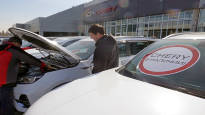According to the Bank of Finland’s Research Institute for Emerging Economies, the Russian economy will shrink by two percent this year.
The Russian economy will shrink by two percent this year, or roughly the same amount as last year, predicts the Bank of Finland’s Research Institute for Emerging Economies (BOFIT).
The drop may sound small, but the change in gross domestic product does not tell everything about the economic plight of Russia, which has transitioned to a war economy. There is enough bad news in the country’s economy.
According to the forecast published by the research institute today, a structural change is taking place in the Russian economy, which “will be a risky process”.
The guidelines that previously guided Russia’s economic policy have been thrown into the scrap heap as a result of the war, and according to the research institute, Russia is now living in a war economy. Due to the war and sanctions, the country has moved from a market economy towards a more state-led self-sufficiency economy.
This means that the role of the state in many sectors of the economy and society has grown. Large companies in particular have become more dependent on those in power than before, says BOFIT’s senior advisor Laura Solanko in the bulletin.
The products become simpler
During the first year of the war, Russia has tried to minimize the effects of sanctions and break away from Western countries. However, self-sufficiency is not easy to achieve.
According to BOFIT, the shortage of foreign components not only increases production costs in Russia, but also forces to resort to lower quality materials.
– Due to the structural change, the end products in some industries will become simpler than before, the forecast says.
One example of this is the new Russian passenger cars, which may no longer have airbags or other similar accessories.
According to BOFIT, due to this ongoing structural change, the productivity of the Russian economy will decrease and the growth rate will slow down. The most recent estimates of Russia’s long-term growth rates are less than one percent per year, the forecast says.
And what does the structural change mean for the Russians themselves?
At least the well-being of Russians is not increasing, BOFIT estimates.
– Breaking away from Western countries and supporting the war effort are difficult goals to combine with increasing the well-being of citizens. In Russia’s economic policy, the choice between the two seems clear based on the first year of the war, the forecast states.
There may be a new economic crisis ahead
According to BOFIT, Russia’s public deficit this year is clearly higher than budgeted. This means that Russia has more public expenditure than it has income. The main reason for the increase in the deficit is the drop in oil prices and the recession, which are eating into Russia’s income.
Forecasting Russia’s economic development is not easy. At the beginning of the war, the Russian economy was estimated to shrink much more than what actually happened. Now uncertainty is caused not only by the course of the war but also by the sustainability of Russia’s public finances, BOFIT estimates.
According to BOFIT, the borrowing of the Russian government cannot grow for a very long time without it starting to accelerate inflation, i.e. a general rise in prices, and displacing private investments. Because of this, Russia may face a new economic crisis, the forecast says.
Listen to the Uutispodcast episode about the state of the Russian economy:
The topic can be discussed until Tuesday at 11 p.m.
